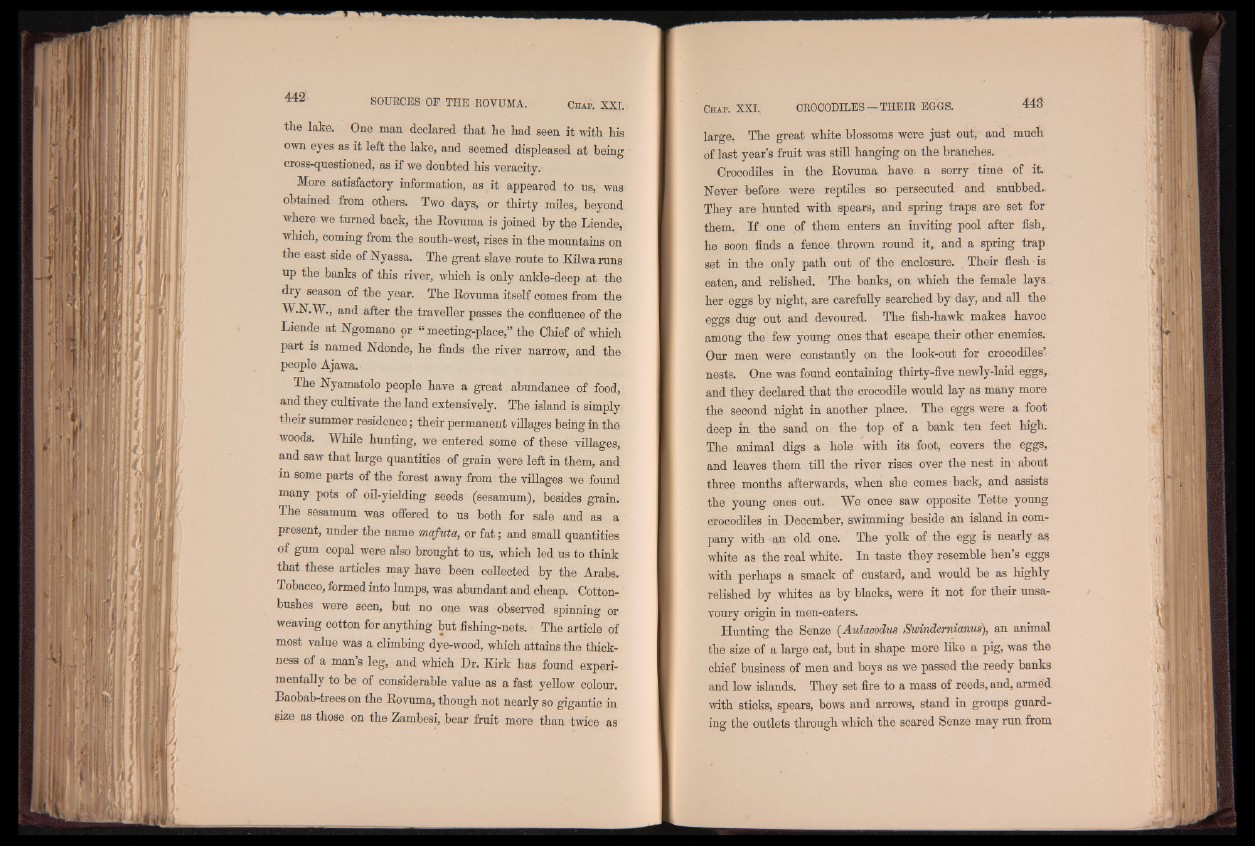
the lake. One man declared that he had seen it with his
own eyes as it left the lake, and seemed displeased at being
cross-questioned, as if we doubted his veracity.
More satisfactory information, as it appeared to us, was
obtained from others. Two days, or thirty miles, beyond
where we turned back, the Eovuma is joined by the Liende,
which, coming from the south-west, rises in the mountains on
the east side of Nyassa. The great slave route to Kilwa runs
up the banks of this river, which is only ankle-deep at the
dry season of the year. The Eovuma itself comes from the
W.N.W., and after the traveller passes the confluence of the
Liende at Ngomano or “ meeting-place,” the Chief of which
part is named Ndonde, he finds the river narrow, and the
people Ajawa.
The Nyamatolo people have a great abundance of food,
and they cultivate the land extensively. The island is simply
their summer residence; their permanent villages being in the
woods. While hunting, we entered some of these villages,
and saw that large quantities of grain were left in them, and
in some parts of the forest away from the villages we found
many pots of oil-yielding seeds (sesamum), besides grain.
The sesamum was offered to us both for sale and as a
present, under the name mafuta, or fa t; and small quantities
of gum copal were also brought to us, which led us to thinV
that these articles may have been collected by the Arabs.
Tobacco, formed into lumps, was abundant and cheap. Cotton-
bushes were seen, but no one was observed spinning or
weaving cotton for anything but fishing-nets. The article of
most value was a. climbing dye-wood, which attains the thickness
of a man s leg, and which Dr. Kirk has found experimentally
to be of considerable value as a fast yellow colour.
Baobab-trees on the Eovuma, though not nearly so gigantic in
gize as those on the Zambesi, bear fruit more than twice as
large. The great white blossoms were just out, and much
of last year’s fruit was still hanging on the branches.
Crocodiles in the Eovuma have a sorry time of it.
Never before were reptiles so persecuted and snubbed..
They are hunted with spears, and spring traps are set for
them. If one of them enters an inviting pool after fish,
he soon finds a fence thrown round it, and a spring trap
set in the only path out of the enclosure. Their flesh is
eaten, and relished. The banks, on which the female lays
her eggs by night, are carefully searched by day, and all the
eggs dug out and devoured. The fish-hawk makes havoc
among the few young ones that escápe their other enemies.
Our men were constantly on the look-out for crocodiles
nests. One was found containing thirty-five newly-laid eggs,
and they declared that the crocodile would lay as many more
the second night in another place. The eggs were a foot
deep in the sand on the top of a bank ten feet high.
The animal digs a hole with its foot, covers the eggs,
and leaves them till the river rises over the nest in about
three months afterwards, when she comes back, and assists
the young ones out. We once saw opposite Tette young
crocodiles in December, swimming beside an island in company
with Tan old one. The yolk of the egg is nearly as
white as the real white. In taste they resemble hen’s eggs
with perhaps a smack of custard, and would be as highly
relished by whites as by blacks, were it not for their unsavoury
origin in men-eaters.
Hunting the Senze (Aulacodus Smndemianus), an animal
the size of a large cat, but in shape more like a pig, was the
chief business of men and boys as we passed the reedy banks
and low islands. They set fire to a mass of reeds, and, armed
with sticks, spears, bows and arrows, stand in groups guarding
the outlets through which the scared Senze may run from.